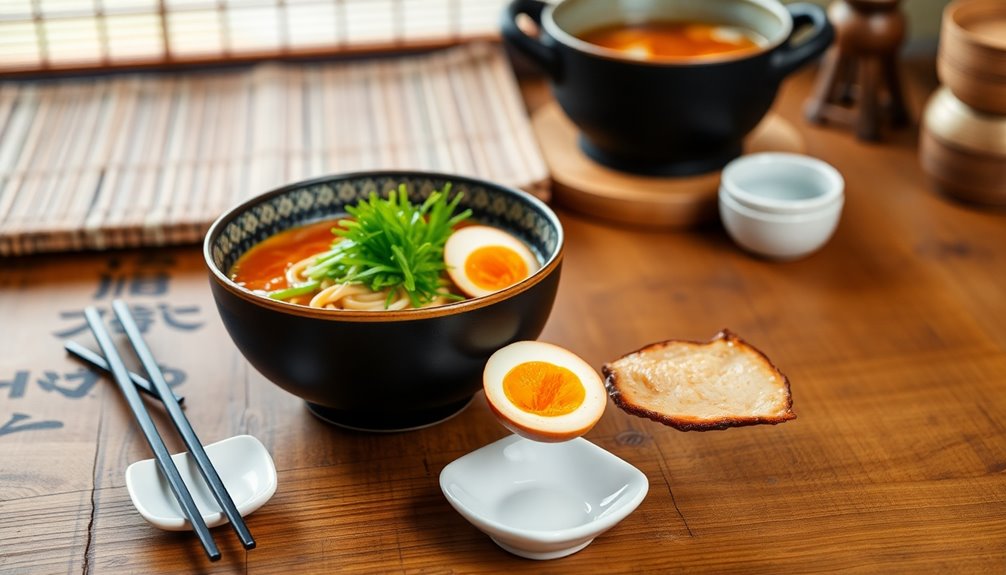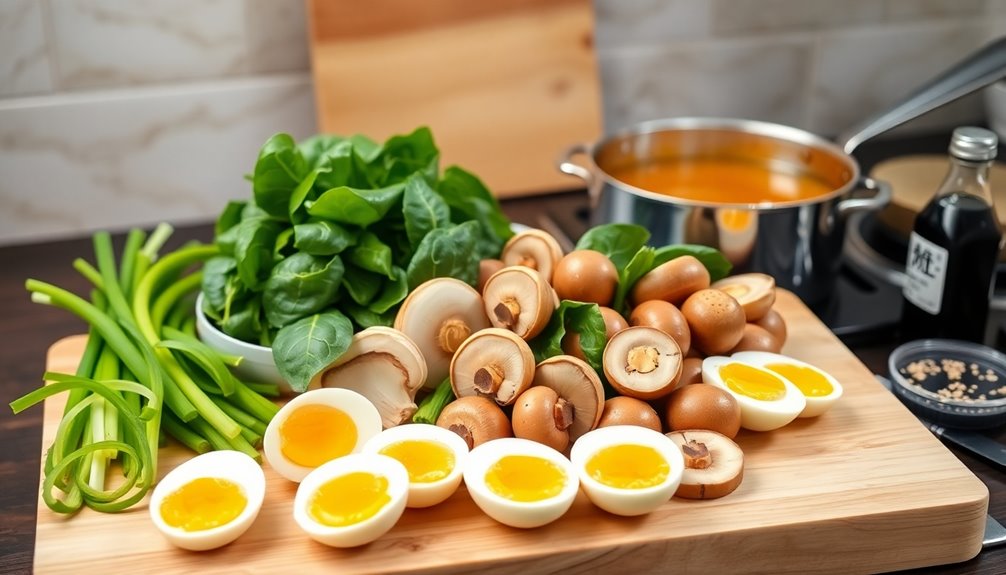Making a delicious bowl of ramen at home is simpler than you think, and it lets you savor comforting flavors inspired by Japanese traditions. Start with a rich broth made from chicken or vegetable stock, soy sauce, and miso paste simmered to perfection. Cook fresh ramen noodles until al dente, then rinse and toss them with a bit of oil. Top your dish with soft-boiled eggs, green onions, chashu, and your favorite fixings. Pour that hot broth over the noodles, and enjoy! You'll discover the joy of customizing and perfecting your own ramen experience as you explore further.
Key Takeaways
- Begin by preparing a rich broth using chicken or vegetable stock, soy sauce, and miso paste, simmering for depth of flavor.
- Cook fresh or dried ramen noodles according to package instructions, ensuring they remain al dente.
- Prepare toppings like slow-cooked chashu, soft-boiled eggs, and chopped green onions to enhance the ramen experience.
- Assemble the dish by pouring hot broth over noodles and artfully layering toppings for visual appeal.
- Serve immediately, garnished with sesame seeds and chili oil, to enjoy the full flavor and warmth of the ramen.
History

Ramen's history is as rich and complex as its flavors, tracing back to Chinese wheat noodles that made their way to Japan in the late 19th century.
As you explore its evolution, you'll find that Japanese chefs began to adapt these noodles, experimenting with different broths and toppings. By the early 20th century, ramen gained popularity, especially in cities like Yokohama.
Post-World War II, the dish transformed further, with instant ramen revolutionizing how people enjoyed this meal.
You might be surprised to learn that each region in Japan has its unique twist on ramen, influenced by local ingredients and culture.
This dish has transcended borders, becoming a global sensation while still honoring its deep-rooted heritage.
Recipe

Ramen is a beloved Japanese dish that has gained popularity all around the world. This comforting noodle soup is perfect for any occasion, whether you're feeling under the weather or simply craving something warm and savory.
The beauty of ramen lies in its versatility, allowing you to customize the broth, noodles, and toppings to suit your taste. In this recipe, we'll focus on making a classic shoyu (soy sauce) ramen that captures the essence of traditional Japanese flavors while being accessible for home cooks.
To make this dish, you'll start with a rich and savory broth that forms the foundation of your ramen. The key is to balance the umami flavors from the soy sauce and other ingredients. You can choose to use store-bought ramen noodles or make your own if you're feeling adventurous.
Finally, the toppings are where you can get creative—feel free to experiment with different ingredients to elevate your bowl of ramen.
Ingredients:
- 4 cups chicken or vegetable broth
- 2 cups water
- 4 tablespoons soy sauce
- 2 tablespoons miso paste
- 1 tablespoon sesame oil
- 2 packs of fresh or dried ramen noodles
- 2 green onions, sliced
- 2 soft-boiled eggs
- 1 cup sliced mushrooms (shiitake or button)
- 1 cup baby spinach or bok choy
- Nori (seaweed) sheets, for garnish
- Sesame seeds, for garnish
To cook the ramen, start by combining the chicken or vegetable broth and water in a large pot over medium heat.
Add the soy sauce, miso paste, and sesame oil, stirring until the miso is fully dissolved. Bring the mixture to a gentle simmer and let it cook for about 10 minutes to allow the flavors to meld.
In the meantime, prepare the ramen noodles according to the package instructions. Once cooked, drain the noodles and divide them into serving bowls.
Pour the hot broth over the noodles and top with sliced mushrooms, spinach or bok choy, soft-boiled eggs, and green onions. Finish with nori sheets and a sprinkle of sesame seeds.
For best results, use high-quality broth, as it greatly impacts the overall flavor of your ramen.
Feel free to experiment with different toppings such as corn, bamboo shoots, or sliced pork for a more traditional approach. Additionally, adjust the seasoning to your preference—if you like it saltier, add more soy sauce, or if you prefer a richer flavor, consider adding a bit of mirin or sake.
Enjoy your homemade ramen!
Cooking Steps

Now that you've gathered your ingredients, it's time to start cooking your ramen.
First, prepare the broth by adding the essential ingredients, then stir in some soy sauce for that rich flavor.
Once you've got the base ready, you can add the noodles and your favorite toppings, letting everything simmer until the flavors meld perfectly.
Step 1. Prepare Broth Ingredients

To create a rich and flavorful broth for your ramen, gather essential ingredients that will form the base of your dish.
Start with high-quality chicken or pork bones; they'll provide depth and richness. Next, add aromatics like onions, garlic, and ginger for a fragrant kick.
Don't forget to include dried shiitake mushrooms or kombu seaweed, which will enhance the umami flavor. For a hint of sweetness, consider adding a few pieces of carrots.
Once you've collected these ingredients, rinse the bones and soak the kombu to remove excess impurities.
You're now ready to move on to the next step of simmering these ingredients to extract all those delicious flavors, creating a broth that's sure to delight your taste buds.
Step 2. Add Soy Sauce

Once the broth has simmered and developed its rich flavors, it's time to add soy sauce for that perfect salty depth.
Start by pouring in about two to three tablespoons of soy sauce, depending on your taste preference. Stir the broth gently to guarantee the soy sauce is evenly distributed.
This step not only enhances the umami flavor but also adds a beautiful color to your ramen. If you prefer a slightly sweeter taste, consider adding a dash of mirin or a bit of sugar to balance the saltiness.
Taste the broth after mixing; feel free to adjust the soy sauce amount to suit your palate. Let it simmer for a few more minutes, allowing those flavors to meld beautifully.
Step 3. Add Noodles to Broth

As you prepare to add the noodles to the simmering broth, make sure the broth is at a gentle boil.
Use fresh ramen noodles for the best texture, but dried noodles work too. Carefully drop the noodles into the pot, ensuring they're submerged in the broth. Stir gently to prevent them from sticking together.
Cook the noodles according to package instructions; this usually takes about 3 to 5 minutes. Keep an eye on them, as overcooked noodles can become mushy.
Once they're al dente, take a taste to check the texture. If they're just right, turn off the heat and get ready for the exciting part—adding your favorite toppings!
Enjoy the aroma of your nearly complete ramen.
Step 4. Add Toppings of Choice

Now's the time to personalize your ramen with an array of delicious toppings. You can start by adding soft-boiled eggs, sliced in half to reveal their creamy yolks.
Next, sprinkle some chopped green onions for a burst of freshness. If you like a bit of heat, toss in some sliced chili peppers or a drizzle of chili oil.
Don't forget nori sheets; they add a nice umami flavor. For a heartier touch, include cooked proteins like sliced pork, chicken, or tofu.
Mushrooms, bean sprouts, and corn also make excellent additions. Finally, a sprinkle of sesame seeds or a dash of soy sauce can elevate your dish.
Mix and match to create the perfect bowl that suits your taste!
Step 5. Simmer Until Flavors Meld

To guarantee your ramen reaches its full potential, you'll want to simmer the broth and toppings together.
Start by bringing the pot to a gentle boil, then reduce the heat to a low simmer. This allows the flavors to meld beautifully. Let it simmer for about 15 to 20 minutes, stirring occasionally.
You'll notice the aroma deepening, as the ingredients release their essence into the broth. Taste it along the way; if you feel it needs a bit more seasoning, add a dash of soy sauce or salt.
Once the flavors are balanced and harmonious, your ramen is ready for the final presentation. Serve hot in bowls, topping with fresh herbs or a drizzle of sesame oil for that extra flair.
Enjoy!
Final Thoughts

While crafting the perfect bowl of ramen may seem challenging, the joy it brings makes every effort worthwhile. As you experiment with flavors and textures, remember that each ingredient plays a crucial role.
Don't hesitate to tweak the recipe to match your taste. Try different broths, toppings, or even noodles to create your unique masterpiece.
Ramen isn't just a meal; it's an experience. Whether you enjoy it solo or share it with friends, it's a fantastic way to connect.
Embrace the process, and don't rush—it's all about savoring the moment.
Frequently Asked Questions
Can I Substitute Instant Ramen Noodles for Fresh Ones?
Yes, you can substitute instant ramen noodles for fresh ones in many dishes.
Instant noodles cook quickly and absorb flavors well, making them a convenient choice.
Just keep in mind that the texture might differ slightly, as fresh noodles are often chewier.
You may need to adjust cooking times, so they don't become too soft.
Experimenting with instant noodles can lead to some tasty results, so don't hesitate to give it a try!
What Are the Best Toppings for Ramen?
When you're thinking about the best toppings for ramen, you've got plenty of delicious options.
Soft-boiled eggs add creaminess, while sliced green onions bring freshness.
Don't forget about nori for a nice umami kick, or bamboo shoots for crunch.
If you like spice, consider adding chili oil or sesame seeds.
For protein, grilled chicken or pork belly works wonders.
Experiment with these toppings to create a bowl that's perfectly suited to your taste!
How Long Does Homemade Ramen Broth Last?
Homemade broth usually lasts about 4 to 5 days in the fridge.
If you want to keep it longer, you can freeze it, and it'll stay good for about 3 months.
When you're ready to use it, just thaw it in the fridge overnight or heat it gently on the stove.
Always check for any off smells or changes in color before using, just to be safe!
Is Ramen Gluten-Free?
Is ramen gluten-free? Unfortunately, traditional ramen isn't gluten-free. It's typically made from wheat flour, which contains gluten.
However, you can find gluten-free alternatives made from rice flour or other gluten-free grains. If you're looking to enjoy ramen while avoiding gluten, check labels carefully and consider making your own noodles.
That way, you can control the ingredients and guarantee a delicious gluten-free experience tailored to your taste!
Can I Make Ramen Vegetarian or Vegan?
Absolutely, you can make ramen vegetarian or vegan!
Simply swap out traditional broth for a vegetable-based option, like mushroom or miso broth. Use plant-based noodles, which are often naturally vegan.
For toppings, load up on fresh vegetables, tofu, or edamame. You can also add seaweed, green onions, and sesame seeds for extra flavor.
With a few simple adjustments, you'll create a delicious and satisfying bowl that fits your dietary preferences!










